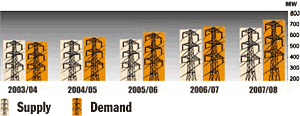 This week's two-hour power cuts caused by the malfunction in one of the three Kali Gandaki turbines proves just how precarious the electricity supply situation in Nepal has become.
This week's two-hour power cuts caused by the malfunction in one of the three Kali Gandaki turbines proves just how precarious the electricity supply situation in Nepal has become. In fact, an internal assessment of the Nepal Electricity Authority (NEA) forecasts power cuts from later this year up to 2008. The reason: surging demand and delays in new power plants like Middle Marsyangdi.
This week's power cuts are temporary and will be lifted once the turbine is fixed but all signs point to long and chronic load shedding in the coming years. This week, NEA has distributed power cuts so no one area suffers more than two hours a week. "We cut power first along the border towns because we can switch them to the Indian grid," says NEA's load dispatch centre chief Shyam Sundar Shrestha.
But by this time next year power cuts will be nationwide and routine because shortfalls in the supply will be an unprecedented 53 megawatts (see chart). At the rate demand is rising, peak load will touch 560 megawatts this year, while the installed capacity is merely 610 megawatts.
The problem is that most of Nepal's power is generated through 'run-of-the-river' schemes which depend on water levels in the rivers and actual production is always below installed capacity. Nepal's power production and consumption is skewed because none of the power plants have large storage reservoirs except Kulekhani. This means power production is highest during the monsoon, when demand is lowest. And when demand peaks in winter and pre-monsoon summer, the rivers are at their lowest.
Urban demand is shooting up because of the influx of people in urban centres due to the insurgency. NEA had forecast an eight percent increase in peak load this year, 7.8 percent next year and almost nine percent in 2007. But supply has been stagnant and no major capacity has been added since the 144 megawatt Kali Gandaki went into operation two years ago. The construction of the 70 megawatt Middle Marsyangdi was supposed to be finished this month but is already two years behind schedule.
 Although small independent power producers have built three hydropower plants, Chakukhola, Sunkosi Small and Rairang, they can cumulatively generate only five megawatts. Other power projects have been delayed because of the insurgency and the military's ban on transporting dynamite for construction. Meanwhile, NEA has a list of 24 major hydro projects that could together generate over 22,000 megawatts but most of them will take at lest 10 years to complete even if construction began right away.
Although small independent power producers have built three hydropower plants, Chakukhola, Sunkosi Small and Rairang, they can cumulatively generate only five megawatts. Other power projects have been delayed because of the insurgency and the military's ban on transporting dynamite for construction. Meanwhile, NEA has a list of 24 major hydro projects that could together generate over 22,000 megawatts but most of them will take at lest 10 years to complete even if construction began right away. The 750 megawatt West Seti Australian joint venture for a mammoth storage dam is making some headway but its power is designed for export to India. India's state-owned National Hydropower Corporation had shown interest in going ahead with the 300 megawatt Upper Karnali project during Sher Bahadur Deuba's visit to New Delhi in September. Even if these two projects were to sell power to the domestic grid, they would not be ready to fill the supply gap between now and 2008.
NEA officials admit they are worried too, and have contingency plans to refurbish the Debighat and Sunkosi power plants and to increase capacity to meet next year's demand. Says NEA Managing Director Janak Lal Karmacharya: "For the next shortage in 2007-8, we are trying to upgrade the capacity of Chilime by adding 40 megawatts to the same system."
If these ideas work, and it is a big if, they may partly be able to meet the rise in demand in the next four years. But if they don't, the resulting power shortage could seriously undermine the economy.
This is the reason why hydropower experts are pushing for a storage type project to generate power even during dry season. "The need for a storage type project was felt long back and Sapta Gandaki was studied," says former NEA managing director, Santa Bahadur Pun. It was the same story with the 122 megawatt Upper Seti reservoir project which was planned for 2010. Political foot-dragging has caused both to gather dust even when the need for a storage project is now becoming urgent.
Some energy experts say since plans to augment supply are slow, immediate attention needs to be paid to the demand side. One way to do this is differential tariffs. "We could avoid load shedding by suppressing peak time demand in the dry season making it more expensive," says senior chartered accountant Ratna Sansar Shrestha, who has been working in the energy sector.
Time-of-the-day pricing has been implemented for the industrial sector but the biggest chunk of power consumers in the country are domestic and non-commercial which would be the target group for peak hour pricing.


